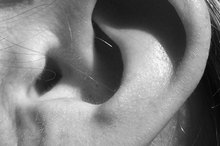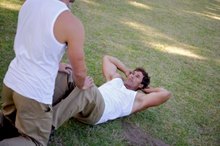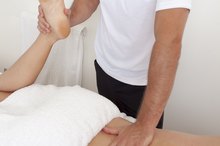How to Cure Inner Ear Crystals
Ear crystals (otolith or otoconia) are tiny calcium carbonate/calcite crystals embedded in the gelatinous otolithic membrane in the inner ear. The otolithic organs (the utricle and the saccule) are what enables you to discern which way is up even when your eyes are closed. If one or more otoconia escape from the otolithic membrane into the inner ear fluid and stimulate the semicircular ear canal, the result can be a sense of rotational vertigo referred to as Benign Paroxysmal Positional Vertigo (BPPV).
If you are experiencing serious medical symptoms, seek emergency treatment immediately.
Ask your doctor to give you the Dix-Hallpike Test. This involves you lying on your back with your head 45 degrees to one side and 20 degrees backward. If he witnesses a burst of nystagmus (the eyes jump up and twist suddenly), then the test is positive for BPPV. He will then probably order lab tests (an ENG–electronystagmography–among others) to rule out any more serious medical condition.
What Are the Treatments for Floating Ear Crystals?
Learn More
Some experts say that BPPV brought on by otoconia can resolve itself after a month or two, that the otoconia can be reabsorbed by “dark cells” in the inner ear labyrinth. If you decide to wait it out, modify your behavior to avoid situations that might bring on the dizziness and vertigo 1. Sleep propped up on two or more pillows, avoid bending over, and avoid other actions that you have noticed set off the symptoms.
If you opt for treatment, one option is the Semont Maneuver. It is performed by a doctor or physical therapist and takes about 15 minutes. While lying down, you are moved rapidly from one side to the other into specific positions. It has been shown to be 90 percent effective after four sessions.
Headache & Nausea After a Fall on My Back
Learn More
Another treatment is the Epley Maneuver (invented by Dr. John Epley). It involves lying back and your doctor turning your head to four different positions sequentially for about 30 seconds each. This treatment is 80 percent effective, with a recurrence rate within one year after treatment of about 30 percent.
The Gans Maneuver (invented by R. Gans PhD) is another treatment; it is performed less often than the Semont or the Epley, and is a hybrid of the two. There isn’t sufficient documentation of this treatment to establish its success rate.
After treatment, wait in the doctors office for 10 minutes before having someone drive you home. Sleep with your head tilted back at a 45 degree angle the night after treatment. Try to keep your head vertical as much as possible the day following treatment.
Tips
If your doctor is not familiar with the treatments for BPPV, you can contact the Vestibular Disorders Association (VEDA) for a referral. (See Reference 2.)
The most common cause of BPPV for those under 50 is head injury, so it is important to you see a doctor to be examined for any serious damage to your ear or head.
Warnings
Do not attempt to perform the treatments without a doctor. Compression of the vertebral arteries can occur producing symptoms such as weakness, numbness and visual changes, and in some cases, a stroke can occur.
Related Articles
References
- Dizziness and Balance.com
- Zalewski, Chris MA, CCC-A. What is Benign Paroxysmal Positional Vertigo (BPPV)?. ASHA 2011
Tips
- If your doctor is not familiar with the treatments for BPPV, you can contact the Vestibular Disorders Association (VEDA) for a referral. (See Reference 2.)
- The most common cause of BPPV for those under 50 is head injury, so it is important to you see a doctor to be examined for any serious damage to your ear or head.
Warnings
- Do not attempt to perform the treatments without a doctor. Compression of the vertebral arteries can occur producing symptoms such as weakness, numbness and visual changes, and in some cases, a stroke can occur.
Writer Bio
Lisa Dorward was a corporate financial executive and business consultant for more than 15 years before becoming a writer in 2003. She has B.A. degrees in both history and creative writing and earned her M.F.A. in creative writing in 2008, specializing in novel-length historical fiction.









